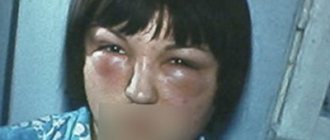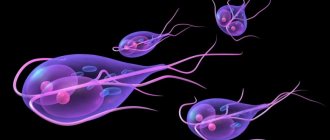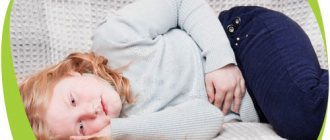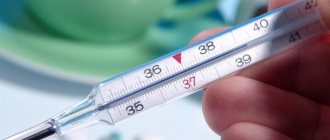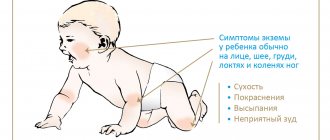A child learns about the world from the moment he begins to crawl on his own. His immune system has not yet been strengthened enough, but the baby can easily taste all unfamiliar objects. With such actions, not only harmful bacteria, but also parasites can penetrate into the unformed body. Most often these are pinworms - helminths that not only cause inconvenience, but can also cause serious illness. How to treat pinworms in children?
What are pinworms in children?
Infection with worms is often caused by eating unwashed fruits.
Enterobiasis is a disease caused by the appearance of pinworms in the small and large intestines of the body. Pinworms are also called worms. These parasites look like small white worms. They are small in size: females up to 1.5 cm, and males up to 5 mm. Their color is always white. The habitat in the human body is the intestines, but there are exceptions when they live in other organs. The female parasite reproduces quite quickly. Every day at night, she can lay eggs near the anus or in the folds of the skin. The affected areas may be the perineum.
During the process of the emergence of worm embryos, the child experiences severe itching as the infected area of the skin becomes vulnerable. Nematodes mature quite quickly and penetrate the intestine and attach themselves to the intestinal walls. After the female has laid eggs, she dies. Girls have a hard time coping with this disease. Worms, crawling out, can penetrate the mucous membrane of the external genitalia, causing additional infections. This does not mean that the disease does not need to be treated. During a short lifespan, a female can lay many eggs. The disease is gaining new momentum and the baby’s condition is worsening.
If no treatment is given, the parasite dies after 50 days.
General information
Enterobiasis refers to a widespread type of helminthiasis , part of the group of parasitic diseases. The disease is characterized by intestinal disorders, nervous system disorders, skin itching and allergic manifestations. Caused by a nematode (roundworm - pinworm). In accordance with the characteristics of the biological development of the parasitic worm, enterobiasis belongs to contact helminths, the characteristic feature of which is the specific development cycle of the parasite:
- The development of the parasite occurs without intermediate hosts.
- Regular release of fully/partially mature eggs from the host’s body.
- Continuation of development after the parasite leaves the intestine on the human body or on surrounding objects, in underwear.
- Oral route of infection through contact with a patient/objects contaminated with eggs.
In areas with a temperate climate (including in countries with high economic development) it is the dominant parasitosis, the proportion of which reaches 70–95% among all helminthiasis, which is due to the independence of the life cycle of pinworms from environmental conditions. On the territory of the Russian Federation, the share of enterobiasis is almost 60% of registered helminthiases and about 200 thousand new cases are registered annually. At the same time, the share of children under the age of 17 years accounts for 96% of cases. Children aged 7 to 14 years (about 50% of cases) and 3 to 6 years (39% of cases) are most susceptible to enterobiasis.
Why are pinworms dangerous? The presence of pinworms in the body of an infested person has a pronounced negative effect on the body of both adults and especially children. Among infected children, there is often a delay in physical/mental and development, decreased immunity , which contributes to increased infectious and somatic morbidity (acute respiratory infections, dysbiosis , intestinal infections) with the development of pathomorphological changes in tissues/organs with a negative effect on the hormonal and enzymatic functions of the body.
Ways of infection by pinworms
It is easy for a child to become infected with such a disease. He leads an active lifestyle, learning new things and playing with other children and animals. A baby can “catch” parasites in several ways:
- Oral. The child scratches the anus and parasite eggs get under the nails. Anything that the baby touches with his hands can be a site of infection.
- Bytovym. After contact with dirty toys, after eating dirty vegetables. This method is the most common. Pinworm larvae remain on the hands and, once they enter the oral cavity, they easily reach a favorable habitat.
- Contact. Favorite pets are the main breeding grounds for worms. Children love to play with them and often do not wash their hands after contact.
The most common cause is failure to maintain normal hygiene. Dirty hands, stale linen, close contact with mucous membranes have a beneficial effect on the appearance of enterobiasis. By teaching your child to be clean, you can protect him from many infections and helminth infections.
Human roundworm
Another prominent representative of roundworms is the roundworm. These helminths are large in size. Females can reach a length of 40 cm, males - up to 25 cm. Most often, parasites live in the small intestine. Roundworms are classified as geohelminths.
This means that their development cycle does not require intermediate hosts. A sick person excretes ascaris eggs along with feces, which then fall into the soil. This is where the larvae develop. The soil has optimal temperature and humidity for this.
It takes about 2 weeks for the eggs to become infective.
Human infection occurs through the fecal-oral mechanism (through food, water and dirty hands). In the stomach, the shells of the eggs are destroyed and the larvae emerge.
They live in the intestines, often leading to injury and obstruction. Sometimes the larvae are carried through the bloodstream to various organs (heart, lungs, brain, sinuses).
It is important that the development of larvae does not necessarily have to take place in the soil. Autoinvasion (self-infection) often occurs.
Signs of pinworms in children
Maintaining personal hygiene - preventing enterobiasis
If a parent notices such symptoms in their child, this may serve as the appearance of “unwanted guests” in the young body:
- Itching in the anal area. This indicates that the female is already laying eggs. Most often, this symptom intensifies at night, when the body is at rest.
- Mechanical damage to the skin in the buttocks area. It is impossible to stop yourself from scratching the infected area. Babies can scratch their skin until it bleeds. This can cause additional complications in the form of infections and inflammation.
- Disorder of the gastrointestinal tract. This symptom indicates that the child has been sick for quite a long time and a large number of helminths live in his body.
- Nervous system disorder. Restless sleep, irritability, and headache can become symptoms of life activity in the intestines of worms.
- Vomiting, pale skin, nausea, fever, dizziness. These are symptoms of intoxication caused by the active work of pinworms. The waste that parasites produce is toxic and spreads throughout the body.
- Detection of mucus in stool. Mucus is the toxic waste of the parasite. It is released and enters the intestines. Detection of “white threads” in the stool. These are the very “worms”. If parents have not identified them in their child’s excrement, this does not mean that he is not sick. The female may not lay eggs every day.
These symptoms cause loss of appetite, resulting in weight loss. Toxic substances secreted by worms most affect the nervous system.
A sick child sleeps poorly, is irritable, pale, motionless, and refuses to eat.
Complications due to the activity of worms
Warning symptoms should not be underestimated. Unfortunately, an untreated problem can cause many complications, the most common of which are:
- problems with concentration, which leads to problems with learning and remembering;
- sleep disorders;
- inflammation of the female genital organs;
- colitis;
- appendicitis;
- dermatitis (caused by constant scratching around the anus);
- weight loss.
Diagnosis of enterobiasis in children
Some believe that infection occurs from pets
If they detect signs of pinworms in their children, parents contact their pediatrician. He, in turn, can prescribe an examination himself, or send him for a consultation with a gastroenterologist and parasitologist. First of all, the specialist will conduct a survey, including basic questions to determine a possible diagnosis. Key questions will include:
- Main complaints
- First symptoms and when they appeared
- How many family members have similar symptoms?
- Does the family practice good hygiene?
The next step will be to assign research:
- Examination of feces. The laboratory takes a stool test for worm eggs. For the analysis to be reliable, it is necessary to take the biomass to the laboratory within an hour after defecation. It is necessary to prevent urine from coming into contact with feces. Analysis from different parts of the stool is collected in a disinfected container. 2 teaspoons are enough for an accurate diagnosis. If the basic rules are not followed, the result may be unreliable.
- Scraping in the anal area. The study is carried out in the morning. The patient should not go to the toilet before this and should not wash himself. The procedure is quite simple: a special film is applied to the skin area. Helminth eggs stick to it, which can be detected under a microscope.
- Blood tests. A general blood test is done. In the presence of enterobiasis, eosinophilia is detected - an increase in eosinophils in the blood. In rare cases, anemia is detected, a decrease in hemoglobin and red blood cells. This disease can be caused by a large number of helminths and a simultaneous infectious disease
If there are any signs of enterobiasis, it is recommended to immediately visit a doctor and undergo the necessary tests. Timely detection and treatment of the disease eliminates the development of complications.
List of sources
- Medical parasitology: textbook / G.I. Myandina, E.V. Tarasenko. M: Practical medicine. 2013. 256 p.
- Avdyukhina T.I., Konstantinova T.N. et al. Enterobiasis. Clinic, diagnosis, treatment, epidemiology, prevention: Textbook. manual for doctors. M., 2003. 56 p.
- Epidemiological characteristics and basics of prevention of contact helminthiases: educational and methodological. allowance / I.N. Valchuk, T.E. Doroshenkov, G.N. Chistenko. – Minsk: BSMU, 2017. –40 s.
- Shreiner E.V. Helminth infections in pediatric clinical practice: issues of diagnosis, therapy, prevention. Rus. honey. magazine 2013.
- Bronshtein A.M., Malyshev N.A., Luchshev V.I., Davydova I.V. Social and epidemiological problems and basic issues of pathology and chemotherapy of helminth infections of the digestive organs. Ross. honey. magazine 2007; 2:33–6.
Treatment of pinworms in children
This is what pinworms look like
It is not recommended to treat pinworms yourself. Parents should definitely seek advice from a doctor. After the examination, a professional will prescribe effective treatment that will help in recovery and will not cause additional harm to health. Experts recommend:
- Maintain hygiene rules for the whole family. Wash your hands before and after eating, and after visiting the toilet.
- Wash your face morning and evening.
- Wet cleaning.
- Bed linen must be clean and ironed. Heat treatment kills helminth eggs.
- Underwear should be changed every day. Wash in hot water and be sure to iron
The most common drugs for the treatment of helminths are:
- Vermox and Medamin. Medicines in tablet form. Prescribed for the whole family. Suitable for children from 2 years old. Has a paralyzing effect on parasites. Dead pinworms leave the body in the stool.
- Piperapzine. The doctor sets the dosage depending on the patient’s age. The medicine has an inhibitory effect on helminths. As a result, parasites cannot remain inside the intestines.
- Pirantel. The tablets actively cope with the disease, regardless of its development. The dosage varies depending on age.
- Pyrvinium pamoate. Suspension effective against pinworms. The drug blocks the work of certain enzymes that are necessary for the life of worms.
It is not recommended to self-medicate and set dosages. Medicines can either cure or harm or worsen the disease. Treatment should only be carried out under medical supervision. Recovery will occur after taking medication for a week. It is possible to prescribe a second course of treatment after 14 days.
Prevention of helminthiasis
If pinworm eggs were found in children, it is recommended that all family members undergo infection prevention at the same time as their treatment. In addition, it is important to treat bedding and clothing from parasite eggs.
How to treat pinworms in adults, and what tablets are suitable not only for the treatment of worms (pinworms), but also for their prevention? The optimal solution would be to choose a drug developed based on natural ingredients. Such an antiparasitic complex is offered by Optisalt. The drug has been certified and proven effective against helminths, their eggs and larvae.
Treatment of pinworms in children using traditional methods
Traditional medicine allows the use of natural ingredients. But this does not mean that it can cure the disease. It can be used as an addition to the doctor’s main prescriptions and after his approval. The most popular home methods:
- Garlic juice. This juice is mixed with water in equal proportions and given to the child before bedtime. You should drink it with a large glass of water. The procedure is carried out over 3 days.
- Onion. The onion is brought to a mushy state and seasoned with sunflower oil. Give to children before bedtime with plenty of water. Use the pulp for 5 days.
- Pumpkin seeds. Raw pumpkin seeds are crushed and seasoned with olive oil. Give a tablespoon three hours before breakfast to children.
- Beetroot juice. Drink half a glass in the morning and before bed. The course lasts 2 weeks.
- Wormwood tincture. Brew a teaspoon of chopped herbs into 300 ml of boiling water. Let it brew for about 10 minutes. After straining, the child should drink the decoction. Carry out the procedure within 4 days. Green vegetables and fruits. It is believed that such products, due to their taste, destroy a favorable environment for the development of parasites.
Manifestations of ascariasis
The development cycle of these worms is about 3 months. This period is the incubation period of the disease. Clinical symptoms of ascariasis are varied. They include:
- the appearance of a rash;
- skin itching;
- slight increase in body temperature;
- decreased appetite;
- nausea;
- flatulence;
- abdominal pain;
- hypersalivation;
- drowsiness;
- weakness;
- irritability.
In severe cases of ascariasis, signs of intestinal obstruction are possible: pain, bloating, constipation. In some cases, adult helminths can be excreted in the feces. Less commonly, ascariasis affects other organs. If roundworms are localized in the eye, oculomotor disorders and hemorrhages are formed. With pulmonary localization, suffocation may occur.
Pinworms - Baby food
“Sadikov's disease” - enterobiasis?
When a child’s body is affected by worms, the mother must take care of the baby’s specific nutrition. Eating the right foods can speed up the healing process. It is worth including in the diet:
- Spicy dishes. Pepper and spicy dressings worsen the habitat for pinworms.
- Sour vegetables and fruits. In an acidic sphere, parasites die faster.
- Horseradish with mustard. Not all kids will like such a specific product. But it undermines active reproduction and temporarily paralyzes the worms.
- Walnuts, flax seeds, pumpkin seeds. Such products help destroy parasites in the intestines.
- Olive and vegetable oil. Relieves irritation of the intestinal walls.
- Dairy products. With their use, medications are better absorbed and the intestinal microflora is not disturbed.
During the period of illness, it is recommended to exclude sweets, fatty foods, and foods with a chemical composition - the consumption of harmful foods creates all the conditions for the further proliferation of pinworms in the child’s body.
Pathogenesis
The leading pathogenetic factors are: mechanical and toxic, as a result of which an inflammatory process is formed in various parts of the intestinal mucosa. Due to the tight fit of the head vesicle of the parasite on the mucous membrane and the penetration of pinworms deep into the tissues, defects in the form of semilunar recesses occur in different parts of the intestine. The severity of the pathological process determines the intensity of the invasion, since pinworms parasitize in large quantities. As a result of irritation of intestinal chemo/mechanoreceptors, a reflex disorder of the motor/secretory function of the gastrointestinal tract develops, which provokes the development of enteritis , gastritis , gastroduodenitis .
The metabolic products of pinworms cause sensitization of the body with the subsequent development of allergic reactions. The immunosuppressive effect of pinworms has been established, which contributes to the development of intestinal infections and dermatoses. Pinworms negatively affect the general condition, the nervous system, especially pronounced in children, their intelligence, behavior, causing increased absent-mindedness , irritability, and worsening memory. The presence of pinworms contributes to disruption of the microbial landscape of normal intestinal flora with frequent development of severe dysbiosis . Enterobiasis negatively affects the course of pregnancy and is often the cause of toxicosis and other pathologies.
Epidemiology.
The source of invasion is a person suffering from enterobiasis (the period of egg release begins 12-14 days after invasion and continues until complete recovery). The transmission mechanism is fecal-oral. Infection occurs when infective eggs are ingested with food and water (food transmission) or when they enter the mouth from fingers and dust (household transmission). Eggs accumulate in large quantities on the perianal area, under the nails of patients, on underwear and bed linen , on household items, chamber pots, toys, carpets, in floor crevices, etc., on food, in soil, and can be spread by flies. The inhalation route is possible - with dust when cleaning the room, when shaking out bedding. This is due to the widespread occurrence of auto(re)invasion in enterobiasis, as a result of which the disease can drag on for a long time.

